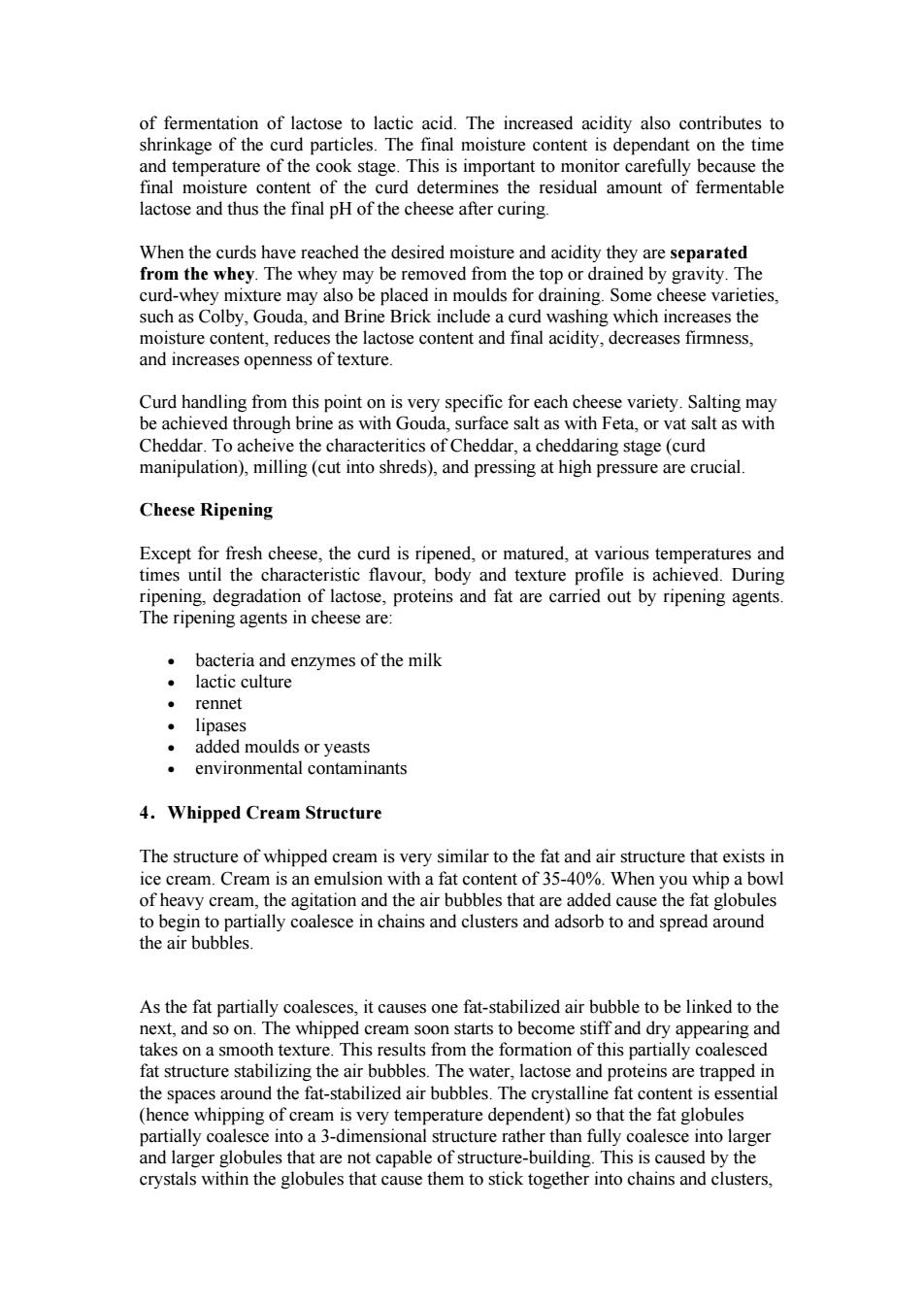正在加载图片...

of fermentation of lactose to lactic acid.The increased acidity also contributes to shrinkage of the curd particles.The final moisture content is dependant on the time and temperature of the cook stage.This is important to monitor carefully because the final moisture content of the curd determines the residual amount of fermentable lactose and thus the final pH of the cheese after curing. When the curds have reached the desired moisture and acidity they are separated ained by gravity.Th eese var oy. Brick es the d conte ose conten idity,decrease s open Curd handling from this point on is very specific for each cheese variety.Salting may be achieved through brine as with Gouda.surface salt as with Feta.or vat salt as with Cheddar.To acheive the characteritics of Cheddar,a cheddaring stage(curd manipulation),milling(cut into shreds),and pressing at high pressure are crucial. Cheese ripening Except for fresh cheese,the curd is ripened,or matured,at various temperatures and times until the characteristic flavour,body and texture profile is achieved.During ripening.degradation of lactose,proteins and fat are carried out by ripening agents The ripening agents in cheese are added moulds or yeasts environmental contaminants 4.Whipped Cream Structure The structure of whipped cream is very similar to the fat and air structure that exists in ice cream.Cream is an emulsion with a fat content of 35-40%.When you whip a bowl of heavy cream,the agitation and the air bubbles that are added cause the fat globules to begin to partially coalesce in chains and clusters and adsorb to and spread around the air bubbles As the fat partially coalesces.it causes one fat-stabilized air bubble to be linked to the next,and so on ne whipp cream soon starts to become stif and ry appea es on a sm extu Thi ng and 0n0 ob: ing th a re trapped】 e spaces aroun d air bubble tial whip is very temperat dep th and la lobule ble of st ed h ther into chains and clustersof fermentation of lactose to lactic acid. The increased acidity also contributes to shrinkage of the curd particles. The final moisture content is dependant on the time and temperature of the cook stage. This is important to monitor carefully because the final moisture content of the curd determines the residual amount of fermentable lactose and thus the final pH of the cheese after curing. When the curds have reached the desired moisture and acidity they are separated from the whey. The whey may be removed from the top or drained by gravity. The curd-whey mixture may also be placed in moulds for draining. Some cheese varieties, such as Colby, Gouda, and Brine Brick include a curd washing which increases the moisture content, reduces the lactose content and final acidity, decreases firmness, and increases openness of texture. Curd handling from this point on is very specific for each cheese variety. Salting may be achieved through brine as with Gouda, surface salt as with Feta, or vat salt as with Cheddar. To acheive the characteritics of Cheddar, a cheddaring stage (curd manipulation), milling (cut into shreds), and pressing at high pressure are crucial. Cheese Ripening Except for fresh cheese, the curd is ripened, or matured, at various temperatures and times until the characteristic flavour, body and texture profile is achieved. During ripening, degradation of lactose, proteins and fat are carried out by ripening agents. The ripening agents in cheese are: • bacteria and enzymes of the milk • lactic culture • rennet • lipases • added moulds or yeasts • environmental contaminants 4.Whipped Cream Structure The structure of whipped cream is very similar to the fat and air structure that exists in ice cream. Cream is an emulsion with a fat content of 35-40%. When you whip a bowl of heavy cream, the agitation and the air bubbles that are added cause the fat globules to begin to partially coalesce in chains and clusters and adsorb to and spread around the air bubbles. As the fat partially coalesces, it causes one fat-stabilized air bubble to be linked to the next, and so on. The whipped cream soon starts to become stiff and dry appearing and takes on a smooth texture. This results from the formation of this partially coalesced fat structure stabilizing the air bubbles. The water, lactose and proteins are trapped in the spaces around the fat-stabilized air bubbles. The crystalline fat content is essential (hence whipping of cream is very temperature dependent) so that the fat globules partially coalesce into a 3-dimensional structure rather than fully coalesce into larger and larger globules that are not capable of structure-building. This is caused by the crystals within the globules that cause them to stick together into chains and clusters